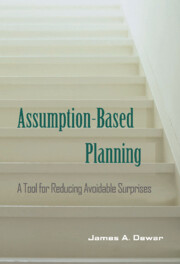Book contents
- Frontmatter
- Contents
- Figures
- Preface
- Acknowledgments
- 1 The essence of Assumption-Based Planning
- 2 A taxonomy of assumptions
- 3 Step 1: identifying assumptions
- 4 Step 2: identifying load-bearing, vulnerable assumptions
- 5 Step 3: identifying signposts
- 6 Step 4: developing shaping actions
- 7 Step 5: developing hedging actions
- 8 The art of conducting ABP
- 9 Beyond ABP as a post-planning tool
- Appendix: Assumption-Based Planning and the planning literature
- Bibliography
- Glossary
- Index
8 - The art of conducting ABP
Published online by Cambridge University Press: 29 October 2009
- Frontmatter
- Contents
- Figures
- Preface
- Acknowledgments
- 1 The essence of Assumption-Based Planning
- 2 A taxonomy of assumptions
- 3 Step 1: identifying assumptions
- 4 Step 2: identifying load-bearing, vulnerable assumptions
- 5 Step 3: identifying signposts
- 6 Step 4: developing shaping actions
- 7 Step 5: developing hedging actions
- 8 The art of conducting ABP
- 9 Beyond ABP as a post-planning tool
- Appendix: Assumption-Based Planning and the planning literature
- Bibliography
- Glossary
- Index
Summary
Over the years, we have come to appreciate how much art there is to any kind of planning. Mintzberg (1994b) argues convincingly that creativity is at the heart of planning and, further, that any attempt to force planning into a rigid framework is likely to squelch that creativity. Creativity is that burst of insight—that “aha!”—that jumps from a thorny problem to its solution. Creativity can be nurtured but not taught. While agreeing with Mintzberg's arguments, I would add that there is an art to planning that is separate from the creativity that he talks about. There is an art to the conducting of planning.
Anyone who has done planning has had good and bad experiences. Largely unrelated to the details of the plan, those experiences had more to do with the people involved, or the circumstances in which the planning was done, or the time of the day, week, or year, etc. As you do more planning, the better you begin to understand what is likely to make for good or bad experiences—and how to turn a bad experience into a good one. Art is something that improves with experience, and it can be taught.
This chapter presents some of the major lessons we have learned about the art of conducting ABP. The major lessons break down into four categories:
Creating the general setup
Identifying load-bearing, vulnerable assumptions
Agreeing on signposts
Introducing scenarios.
- Type
- Chapter
- Information
- Assumption-Based PlanningA Tool for Reducing Avoidable Surprises, pp. 154 - 171Publisher: Cambridge University PressPrint publication year: 2002



